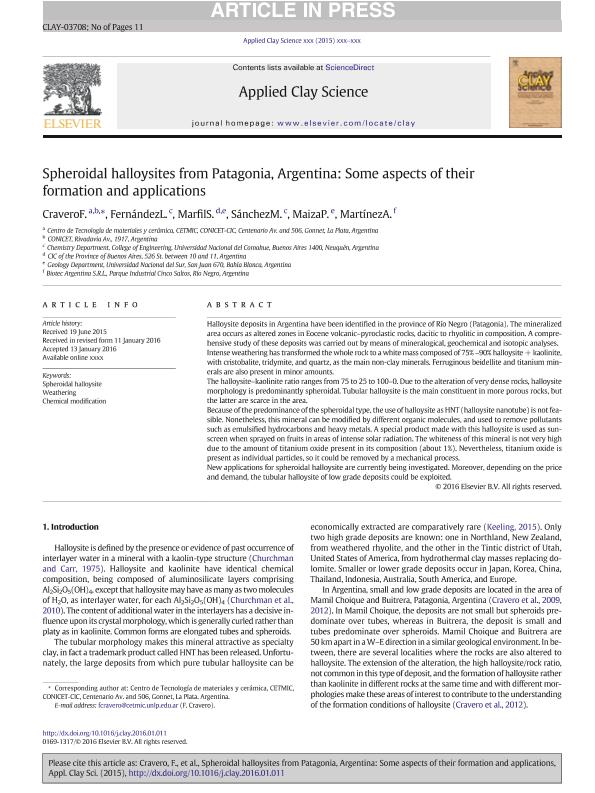Mostrar el registro sencillo del ítem
dc.contributor.author
Cravero, Maria Fernanda

dc.contributor.author
Fernández, L.
dc.contributor.author
Marfil, S.
dc.contributor.author
Sánchez, M.
dc.contributor.author
Maiza, Pedro Jose

dc.contributor.author
Martínez, A.
dc.date.available
2018-06-18T21:15:34Z
dc.date.issued
2016-10
dc.identifier.citation
Cravero, Maria Fernanda; Fernández, L.; Marfil, S.; Sánchez, M.; Maiza, Pedro Jose; et al.; Spheroidal halloysites from Patagonia, Argentina: Some aspects of their formation and applications; Elsevier Science; Applied Clay Science; 131; 10-2016; 48-58
dc.identifier.issn
0169-1317
dc.identifier.uri
http://hdl.handle.net/11336/49177
dc.description.abstract
Halloysite deposits in Argentina have been identified in the province of Río Negro (Patagonia). The mineralized area occurs as altered zones in Eocene volcanic–pyroclastic rocks, dacitic to rhyolitic in composition. A comprehensive study of these deposits was carried out by means of mineralogical, geochemical and isotopic analyses. Intense weathering has transformed the whole rock to a white mass composed of 75% –90% halloysite + kaolinite, with cristobalite, tridymite, and quartz, as the main non-clay minerals. Ferruginous beidellite and titanium minerals are also present in minor amounts. The halloysite–kaolinite ratio ranges from 75 to 25 to 100–0. Due to the alteration of very dense rocks, halloysite morphology is predominantly spheroidal. Tubular halloysite is the main constituent in more porous rocks, but the latter are scarce in the area. Because of the predominance of the spheroidal type, the use of halloysite as HNT (halloysite nanotube) is not feasible. Nonetheless, this mineral can be modified by different organic molecules, and used to remove pollutants such as emulsified hydrocarbons and heavy metals. A special product made with this halloysite is used as sunscreen when sprayed on fruits in areas of intense solar radiation. The whiteness of this mineral is not very high due to the amount of titanium oxide present in its composition (about 1%). Nevertheless, titanium oxide is present as individual particles, so it could be removed by a mechanical process. New applications for spheroidal halloysite are currently being investigated. Moreover, depending on the price and demand, the tubular halloysite of low grade deposits could be exploited.
dc.format
application/pdf
dc.language.iso
eng
dc.publisher
Elsevier Science

dc.rights
info:eu-repo/semantics/openAccess
dc.rights.uri
https://creativecommons.org/licenses/by-nc-sa/2.5/ar/
dc.subject
Chemical Modification
dc.subject
Spheroidal Halloysite
dc.subject
Weathering
dc.subject.classification
Meteorología y Ciencias Atmosféricas

dc.subject.classification
Ciencias de la Tierra y relacionadas con el Medio Ambiente

dc.subject.classification
CIENCIAS NATURALES Y EXACTAS

dc.title
Spheroidal halloysites from Patagonia, Argentina: Some aspects of their formation and applications
dc.type
info:eu-repo/semantics/article
dc.type
info:ar-repo/semantics/artículo
dc.type
info:eu-repo/semantics/publishedVersion
dc.date.updated
2018-06-18T13:30:44Z
dc.journal.volume
131
dc.journal.pagination
48-58
dc.journal.pais
Países Bajos

dc.journal.ciudad
Amsterdam
dc.description.fil
Fil: Cravero, Maria Fernanda. Provincia de Buenos Aires. Gobernación. Comisión de Investigaciones Científicas. Centro de Tecnología de Recursos Minerales y Cerámica. Consejo Nacional de Investigaciones Científicas y Técnicas. Centro Científico Tecnológico Conicet - La Plata. Centro de Tecnología de Recursos Minerales y Cerámica; Argentina
dc.description.fil
Fil: Fernández, L.. Universidad Nacional del Comahue; Argentina
dc.description.fil
Fil: Marfil, S.. Provincia de Buenos Aires. Gobernación. Comisión de Investigaciones Científicas; Argentina
dc.description.fil
Fil: Sánchez, M.. Universidad Nacional del Comahue; Argentina. Universidad Nacional del Sur; Argentina
dc.description.fil
Fil: Maiza, Pedro Jose. Consejo Nacional de Investigaciones Científicas y Técnicas; Argentina. Universidad Nacional del Sur; Argentina
dc.description.fil
Fil: Martínez, A.. Universidad Nacional del Sur; Argentina. Biotec Argentina S.R.L; Argentina
dc.journal.title
Applied Clay Science

dc.relation.alternativeid
info:eu-repo/semantics/altIdentifier/doi/https://dx.doi.org/10.1016/j.clay.2016.01.011
dc.relation.alternativeid
info:eu-repo/semantics/altIdentifier/url/https://www.sciencedirect.com/science/article/pii/S0169131716300126
Archivos asociados
